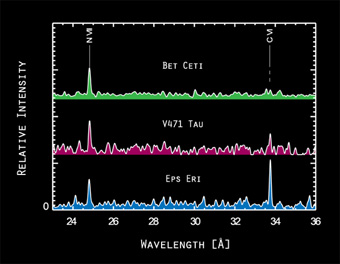January 30, 2004
CXC RELEASE: 04-01
Astronomers have used an observation by NASA's Chandra X-ray Observatory to make the best case yet that a star can be engulfed by its companion star and survive. This discovery will help astronomers better understand how closely coupled stars, and perhaps even stars and planets, evolve when one of the stars expands enormously in its red giant phase.
The binary star system known as V471 Tauri comprises a white dwarf star (the primary) in a close orbit -- one thirtieth of the distance between Mercury and the Sun -- with a normal Sun-like star (the secondary). Chandra's data showed that the hot upper atmosphere of the secondary star has a deficit of carbon atoms relative to nitrogen atoms.
"This deficit of carbon atoms is the first clear observational evidence that the normal star was engulfed by its companion in the past," according to Jeremy Drake of the Smithsonian Astrophysical Observatory in Cambridge, MA, who coauthored an article on V471 in The Astrophysical Journal Letters with Marek Sarna of the N. Copernicus Astronomical Center in Poland.
The white dwarf star was once a star several times as massive as the Sun. Nuclear fusion reactions in the core of such a star convert carbon into nitrogen over a period of about a billion years. When the fuel in the core of the star is exhausted, the core collapses, triggering more energetic nuclear reactions that cause the star to expand and transform into a red giant before eventually collapsing to become a white dwarf.
The carbon-poor material in the core of the red giant is mixed with outer part of the star, so its atmosphere shows a deficit of carbon, as compared with Sun-like stars. The X-ray spectra of a red giant star (top panel) and a Sun-like star (bottom panel) show the large difference in the peaks due to carbon atoms in the two stars.
Theoretical calculations indicate that a red giant in a binary system can completely envelop its companion star and dramatically affect its evolution. During this common envelope phase, friction causes the companion star to spiral inward rapidly where it will either be destroyed by the red giant, or it will survive when much of the envelope is spun away.
If the companion star manages to survive, it will bear the marks of its ordeal in the form of contamination by carbon-poor material that it accreted while it was inside the red giant envelope. The X-ray spectrum of V471 Tauri in the middle panel shows just this effect - the carbon peak is intermediate between that of a Sun-like star and an isolated red giant star. The data indicate that about 10 percent of the star's mass has been accreted from the red giant.
In the future the companion star can return the favor when it expands and dumps material back onto the white dwarf. If enough material is dumped on the white dwarf, it could cause the white dwarf to explode as a supernova. "It's a dog-eat-dog world out there," observed Drake.
V471 Tau was observed for approximately one day by Chandra using the Low Energy Transmission Grating and High Resolution Camera on January 24-25, 2002.
NASA's Marshall Space Flight Center, Huntsville, Ala., manages the Chandra program for the Office of Space Science, NASA Headquarters, Washington. Northrop Grumman of Redondo Beach, Calif., formerly TRW, Inc., was the prime development contractor for the observatory. The Smithsonian Astrophysical Observatory controls science and flight operations from the Chandra X-ray Center in Cambridge, Mass.
MEDIA CONTACTS
Steve Roy
Marshall Space Flight Center, Huntsville, AL
Phone: 256-544-6535
Megan Watzke
Chandra X-ray Observatory Center, CFA, Cambridge, MA
Phone: 617-496-7998
cxcpress@cfa.harvard.edu



